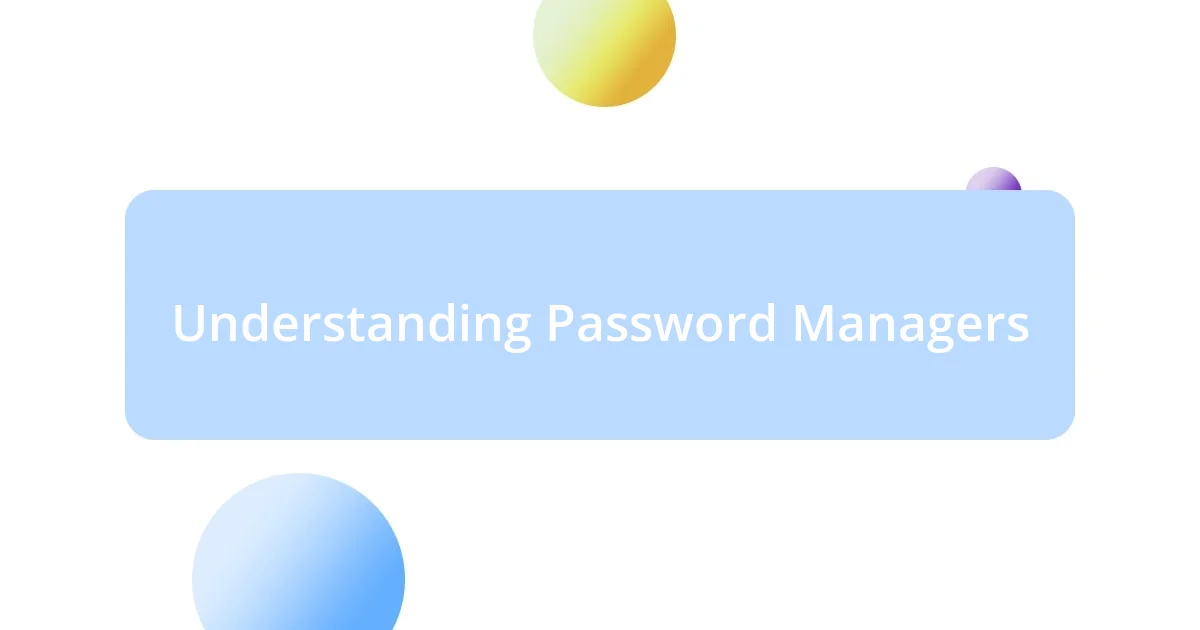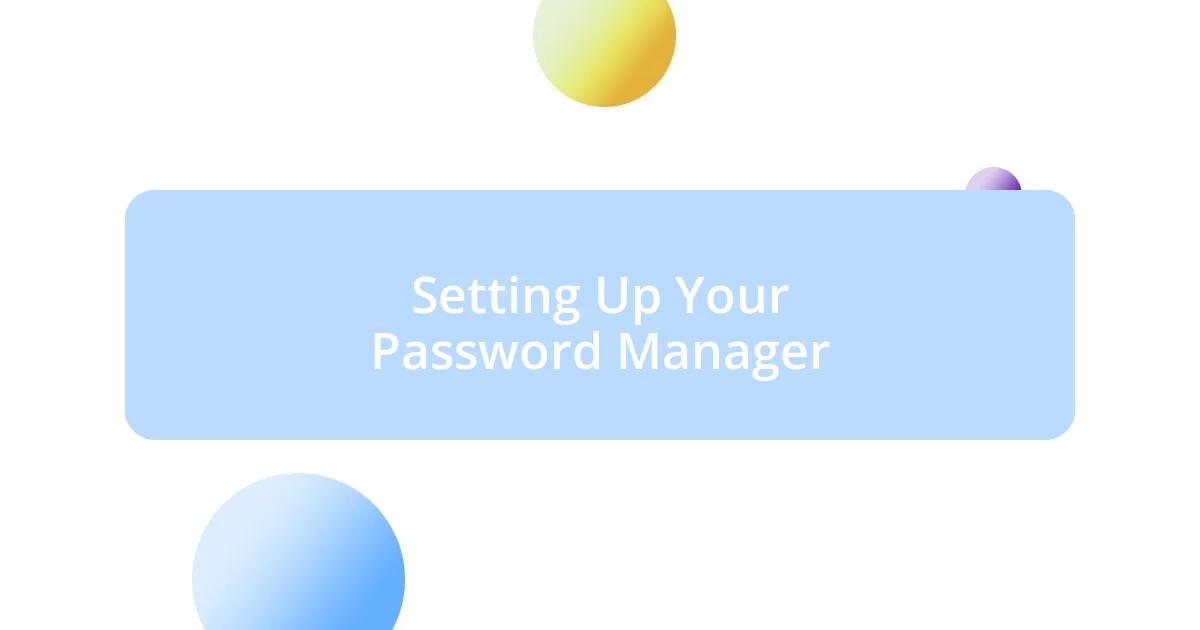Key takeaways:
- Password managers securely store passwords and generate strong, unique passwords, reducing the risk of cyberattacks.
- When choosing a password manager, prioritize security features, compatibility, user interface, and customer support.
- Regularly evaluate the performance of your password manager to ensure it meets evolving security standards and personal needs.

Understanding Password Managers
Password managers are essentially digital vaults that securely store all of your passwords and sensitive information. I remember the first time I decided to rely on one; it was like having a personal assistant who not only remembers everything for me but also keeps it locked away from prying eyes. Can you imagine the peace of mind that comes from knowing you no longer have to remember every complex password you’ve created?
What’s fascinating about password managers is how they generate strong, unique passwords automatically, which minimizes the risk of falling victim to cyberattacks. I used to struggle with coming up with complicated passwords, often reverting to easily guessable ones because I couldn’t remember them. It struck me in that moment how crucial these tools are for protecting our digital identities—how they transform a cumbersome chore into a seamless process.
Moreover, many password managers offer features beyond just storing passwords, like secure notes or two-factor authentication. Once, when I was about to make an online purchase, I realized I had forgotten my password. In mere seconds, my password manager auto-filled the login details, saving me from the hassle of resetting it on the spot. Isn’t it amazing how a little convenience can significantly enhance our daily online experiences?

Choosing the Right Password Manager
Choosing the right password manager is crucial for ensuring your online security is as strong as possible. I remember feeling overwhelmed by the sheer number of options available. It helped to create a shortlist based on my own needs. For me, ease of use and security features were at the top of my priority list. Here’s what I considered when selecting a password manager:
- Security Features: Look for end-to-end encryption and zero-knowledge architecture, so even the provider can’t access your data.
- Compatibility: It should seamlessly work across all devices and browsers you use.
- User Interface: A clean, intuitive design makes it easier to manage your passwords without feeling frustrated.
- Affordable Pricing: Consider both free and premium options but ensure that it fits your budget while offering robust features.
- Customer Support: Responsive support can make all the difference if you encounter issues or have questions.
As I delved deeper, I realized that some managers offer bonus features like password health checks or dark web monitoring. I remember one night after changing several passwords, my password manager alerted me that one of my saved passwords had been compromised in a data breach. That feeling of alarm quickly transformed into gratitude when I saw how quickly I could update my details without missing a beat. This type of proactive feature definitely influenced my final choice, as I wanted a tool that not only stored my passwords but also helped keep them safe.

Setting Up Your Password Manager
Setting up your password manager is an exciting first step toward improving your online security. When I first started, the setup process felt a little daunting, but I quickly discovered it was quite straightforward. Usually, you begin by creating an account with a strong master password—this is the key to your vault. I vividly recall spending some time crafting my master password; I wanted it to be both memorable but difficult to guess, striking a balance that felt satisfying.
Once you’ve created your account, it’s time to populate your vault. I found that importing existing passwords from my browser was a great way to jumpstart things. Some managers allow for CSV file imports, which can save a ton of time. My own experience was filled with the small thrill of seeing my chaos of passwords turn into organized entries. It’s almost like decluttering your digital life. I can remember when I saw everything neatly categorized; it gave me a sense of control that I hadn’t realized I was missing.
Lastly, be sure to explore the settings within your password manager once you’ve filled your vault. I learned the hard way that customizing security options can vastly enhance my experience. For example, I enabled two-factor authentication on my account after reading about potential vulnerabilities online. It was an extra step, but watching those additional layers of security locked my passwords down felt incredibly reassuring. More often than not, I found myself developing a routine of checking these settings regularly, as it eased my mind knowing I was doing everything possible to safeguard my information.
| Feature | Importance |
|---|---|
| Master Password Creation | Strong initial security |
| Password Importing | Saves time in setup |
| Customization Settings | Enhanced overall security |

Common Issues with Password Managers
One common issue I’ve encountered with password managers is their reliability during critical moments. I remember trying to log into my accounts on a particularly hectic morning when, to my frustration, the password manager didn’t autofill as expected. That moment made me wonder, “What if I had an urgent need to access a vital service?” Inconsistent performance can lead to unnecessary stress, reminding me how crucial it is to find a reliable tool that functions smoothly under pressure.
Another challenge is the tendency to become overly dependent on these tools. At one point, I realized I had granted my password manager access to nearly every aspect of my online life. This dependency can feel comforting, but it also raises questions about control. I began to wonder, “What if something goes wrong with the manager itself?” It led me to think more about regular password updates and maintaining my personal security practices, rather than relying solely on the technology.
I’ve also noticed that some password managers can be tricky when syncing across devices. I once faced the aggravation of finding an updated password on my desktop but not seeing it on my phone. It left me questioning whether I had saved it correctly or if there was a syncing error. This experience taught me the importance of regularly checking that my passwords were consistent across all platforms to avoid any potential hiccups in accessing my accounts.

Securely Storing Sensitive Information
When it comes to securely storing sensitive information, I can’t emphasize enough the importance of encryption. A password manager encrypts your data, turning it into an unreadable format that only you, with your master password, can decode. This layer of security was a game-changer for me; I remember feeling a wave of relief knowing that even if someone managed to access the data, they’d be left with a jumble of characters.
I often found myself reflecting on how sensitive information isn’t just passwords. For instance, I store personal documents and financial details within my password manager. Initially, I was hesitant about this, but I realized that using a reputable tool for this purpose offered peace of mind. The first time I saved my bank information, I thought, “Am I really ready for this?” Yet, once I saw the vault’s secure design, it felt liberating to know everything was organized in one safe place.
One experience that stands out is when I accidentally shared a password with someone who wasn’t supposed to have it. It made me realize how essential it is to keep sensitive data compartmentalized. Using specific features like password sharing allowed me to control what information I divulged, which felt empowering and responsible. I always check to easily revoke access, often thinking to myself, “Better safe than sorry,” reinforcing my commitment to maintaining tight security over my personal information.

Evaluating Password Managers Over Time
Evaluating password managers over time is an enlightening journey. I’ve noticed that the features of these tools evolve, but so do my expectations. For instance, I initially settled for basic security and autofill functions, but as I became more aware of the importance of digital security, I found myself demanding advanced features like secure sharing options and biometric authentication. It made me think, “Am I choosing a password manager that will grow with me?”
As I reflected on my experiences, one thing stood out: not all password managers adapt equally to changes in technology and security threats. I remember switching from one provider to another because the one I was using didn’t upgrade their security measures fast enough. It felt like I was safeguarding an old fortress instead of building a stronger one. This experience taught me that regularly reviewing the performance of my password manager is as crucial as the initial choice. Are you keeping up with the latest security standards?
Over time, I’ve also learned the importance of user experience. I recall an early encounter where the interface of my first password manager was so clunky that I found myself frustrated during a time-crunch situation. I sat there wondering, “Why should I be fighting with my password manager when it should be my ally?” With this realization, I now prioritize tools that not only secure my data but also make it easy for me to navigate quickly. My experience has shown me that as our needs change, it’s essential to evaluate whether our password managers keep pace with both technology advancements and personal expectations.














